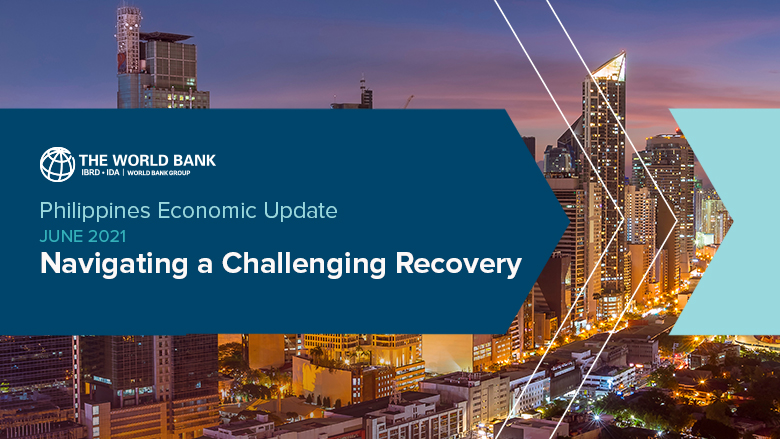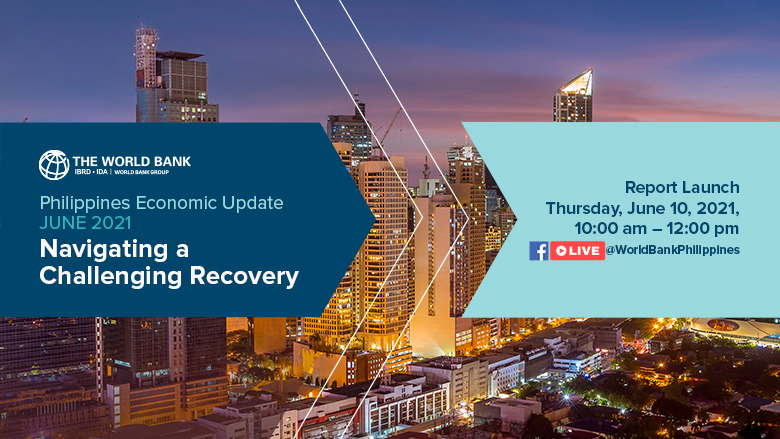Recent Economic and Policy Developments
- The economy remained in recession, contracting by 4.2% year-on-year in the first quarter of 2021. The growth contraction was fueled by weak domestic demand, driven by the combination of containment measures, weak confidence, and rising inflation.
- Meanwhile, tepid external demand was driven by the sharp contraction in services exports amid lingering restrictions and weak demand for international tourism while goods exports recovered.
- The public sector was the main driver of growth with an expansionary budget.
- The impact of the recession is broad-based, affecting all sectors, i.e. industry, construction, manufacturing, services, trade, transportation, accommodation and food services.
- The Central Bank of the Philippines (Bangko Sentral ng Pilipinas) maintained its key policy rate at 2.0% throughout the first four months of 2021 to support the economic recovery.
- The authorities also accelerated public spending. Stimulus spending and infrastructure investment drove public spending from 19.1% of GDP in the first quarter of 2020 to 23.4% of GDP in the same period in 2021.
- The unemployment rate decreased to 7.1% in March 2021 after remaining steady at 8.7-8.8% in the past five months.
Outlook and Risks
- The growth prospects hinge on the country’s ability to manage the COVID-19 health crisis.
- The economy is projected to expand at 4.7% in 2021, before accelerating to 5.9% in 2022 and 6.0% in 2023. The economic recovery will contribute to renewed progress in poverty reduction.
- Growth prospects are subject to significant downside risks.
- A resurgence of infection due to the entry of new virus variants is the most significant risk, which may yet overwhelm the healthcare system.
- Ineffectively containing the virus or implementing the mass vaccination program may extend mobility restrictions, which could lead to further job and income losses, disrupt businesses, and delay economic recovery.
- External risks include a slower-than-expected global recovery, disruptions in international logistics and global value chains, and trade protectionism.
Policy Recommendations
- The key health policy response remains the management of the virus and roll out of the vaccination program.
- Effectively delivering social protection programs will help reduce the extent to which the crisis adversely affects long term human capital accumulation.
- Mobilizing greater private sector participation in public infrastructure projects will be important as the government faces limited fiscal space in the short term.
- Relaxing restrictions on FDI is expected to boost the economic recovery.
Special Focus on Subnational Finance
Local governments have played a crucial role at the front lines of the COVID crisis. A current lack of resources prevents local government units (LGUs) from fulfilling their devolved mandates.
- The Mandanas Ruling that will be implemented in 2022 is the first step towards strengthening decentralization and improving local service delivery.
- Large disparities in LGUs’ financial resources have led to persistent inequalities across LGUs.
- Implementation challenges can be addressed successfully through improved coordination and strategic planning and budgeting.
- Addressing the structural challenges of decentralization requires a long-term investment in designing institutional arrangements that will ensure the success of decentralization.
- Policy Recommendations for the implementation of the Mandanas Ruling
- Short-term
- Clearly define, communicate, and coordinate the re devolution of functions.
- Minimize inefficient allocation of LGU budgets by focusing on implementation ready programs and projects.
- Medium-term
- Support capacity building in local government units.
- Reduce inequality by re devolving gradually and targeting national government support toward disadvantaged LGUs.
- Strengthen systems of monitoring and evaluation within government.
- Long-term
- Amend the Local Government Code to address fundamental challenges towards effective service delivery.
- Strengthen demand for transparency and accountability.
- Short-term



